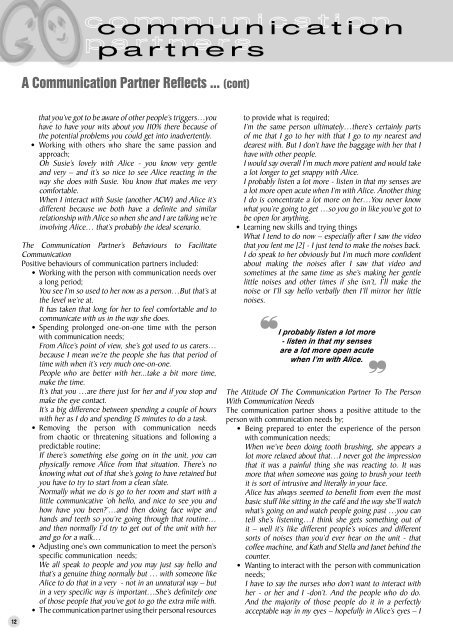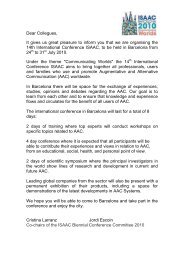May 2008 Edition - agosci
May 2008 Edition - agosci
May 2008 Edition - agosci
You also want an ePaper? Increase the reach of your titles
YUMPU automatically turns print PDFs into web optimized ePapers that Google loves.
ccommunicationo m m u n i c a t i o nppartnersa r t n e r sA Communication Partner Reflects ... (cont)12that you’ve got to be aware of other people’s triggers…youhave to have your wits about you 110% there because ofthe potential problems you could get into inadvertently.• Working with others who share the same passion andapproach;Oh Susie’s lovely with Alice - you know very gentleand very – and it’s so nice to see Alice reacting in theway she does with Susie. You know that makes me verycomfortable.When I interact with Susie (another ACW) and Alice it’sdifferent because we both have a defi nite and similarrelationship with Alice so when she and I are talking we’reinvolving Alice… that’s probably the ideal scenario.The Communication Partner’s Behaviours to FacilitateCommunicationPositive behaviours of communication partners included:• Working with the person with communication needs overa long period;You see I’m so used to her now as a person…But that’s atthe level we’re at.It has taken that long for her to feel comfortable and tocommunicate with us in the way she does.• Spending prolonged one-on-one time with the personwith communication needs;From Alice’s point of view, she’s got used to us carers…because I mean we’re the people she has that period oftime with when it’s very much one-on-one.People who are better with her...take a bit more time,make the time.It’s that you …are there just for her and if you stop andmake the eye contact.It’s a big difference between spending a couple of hourswith her as I do and spending 15 minutes to do a task.• Removing the person with communication needsfrom chaotic or threatening situations and following apredictable routine;If there’s something else going on in the unit, you canphysically remove Alice from that situation. There’s noknowing what out of that she’s going to have retained butyou have to try to start from a clean slate.Normally what we do is go to her room and start with alittle communicative ‘oh hello, and nice to see you andhow have you been?’…and then doing face wipe andhands and teeth so you’re going through that routine…and then normally I’d try to get out of the unit with herand go for a walk…• Adjusting one’s own communication to meet the person’sspecifi c communication needs;We all speak to people and you may just say hello andthat’s a genuine thing normally but … with someone likeAlice to do that in a very - not in an unnatural way – butin a very specific way is important…She’s defi nitely oneof those people that you’ve got to go the extra mile with.• The communication partner using their personal resourcesto provide what is required;I’m the same person ultimately…there’s certainly partsof me that I go to her with that I go to my nearest anddearest with. But I don’t have the baggage with her that Ihave with other people.I would say overall I’m much more patient and would takea lot longer to get snappy with Alice.I probably listen a lot more - listen in that my senses area lot more open acute when I’m with Alice. Another thingI do is concentrate a lot more on her…You never knowwhat you’re going to get …so you go in like you’ve got tobe open for anything.• Learning new skills and trying thingsWhat I tend to do now – especially after I saw the videothat you lent me [2] - I just tend to make the noises back.I do speak to her obviously but I’m much more confi dentabout making the noises after I saw that video andsometimes at the same time as she’s making her gentlelittle noises and other times if she isn’t, I’ll make thenoise or I’ll say hello verbally then I’ll mirror her littlenoises.I probably listen a lot more- listen in that my sensesare a lot more open acutewhen I’m with Alice.The Attitude Of The Communication Partner To The PersonWith Communication NeedsThe communication partner shows a positive attitude to theperson with communication needs by;• Being prepared to enter the experience of the personwith communication needs;When we’ve been doing tooth brushing, she appears alot more relaxed about that…I never got the impressionthat it was a painful thing she was reacting to. It wasmore that when someone was going to brush your teethit is sort of intrusive and literally in your face.Alice has always seemed to benefi t from even the mostbasic stuff like sitting in the café and the way she’ll watchwhat’s going on and watch people going past …you cantell she’s listening…I think she gets something out ofit – well it’s like different people’s voices and differentsorts of noises than you’d ever hear on the unit - thatcoffee machine, and Kath and Stella and Janet behind thecounter.• Wanting to interact with the person with communicationneeds;I have to say the nurses who don’t want to interact withher - or her and I -don’t. And the people who do do.And the majority of those people do it in a perfectlyacceptable way in my eyes – hopefully in Alice’s eyes – I





